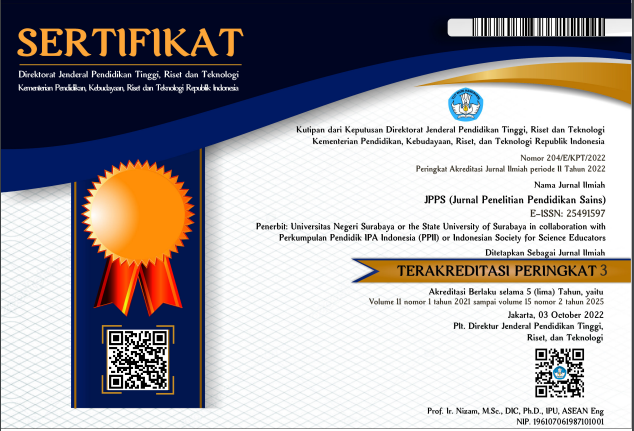THE PRACTICALLITY OF PO2E2W LEARNING MATERIAL MODEL ASSISTED PHET MEDIA TO IMPROVE THE STUDENTS PHYSICS PROBLEM SOLVING SKILLS
DOI:
https://doi.org/10.26740/jpps.v8n1.p%25pKeywords:
PhET media, practicality of PO2EW model, problem solving skillsAbstract
PO2E2W learning model (problem orientation, observation, explanation, elaboration, and write in science) assisted by PhET media is a learning model that is oriented towards self regulated learning which in the process of physics learning activities is carried out with the help of PhET media. The purpose of this study was to analyze the practicality of the PO2E2W model assisted by PhET media in improving the physics problem solving skills of high school students. This research was carried out at Kemala Bhayangkari 1 High School (Surabaya, Indonesia) for students of class XI IPA 1, XI IPA 2 and XI IPA 3. Criteria for practicality of learning devices in this study were based on (1) the implementation of the learning implementation plan (RPP) during one meeting in class XI IPA 1 and the implementation of the learning plan (RPP) for five meetings in class XI IPA 2 and XI IPA 3, (2) obstacles during learning activities. The number of observers in this study is two observers. The aspects observed consisted of introduction, core and closing activities. Based on the results of the practicality study of the PO2E2W model assisted by PhET media, the results obtained (1) the average assessment of two observers in class XI IPA 1 was 3.30 with good category with a percentage of agreement 96.75%, XI IPA 2 was 3.71 in very both with a percentage of agreement 95.84% and in class XI IPA 3 was 3.76 in very good category with a percentage of agreement 96.85% (2) obstacles during learning activities that can be overcome properly. Conclusion based on the results of the study of the freeness of the PO2E2W model assisted by PhET media is practically applied in learning to improve the physics problem solving skills of senior high school students.Downloads
References
Abell, S. K. (2006). On writing in science. Science and children, 60-61.
Baker, W. P., Barstack, R., Clark, D., Hull, E., Goodman, B., Kook, J., dll. (2008). Writing to learn in the inquiry science classroom: Effetive strategies from middle school science and writing teachers. Procedia Journal. Doi: 10.1015/j.sbspro.2014.05.510.
Borichh, G. (Observation Skills for Effective Teaching). (1994). USA:Macmilan Publishing Company.
BSNP. (2010). Paradigma Pendidikan Nasional Abad XXI. Badan Standar Nasional Pendidikan Versi 1. Jakarta.
Hakkarainen, O., & Ahtee, M. (2010). Pupils connecting observations and explanations in successive demonstrations. Journal of Baltic Science Learning and Teaching, 12, Issue I (Juni 2011)
Kracjcik, J.,&McNeil, K. L. (2009). Designing instructional materials to support students in writing scientific explanations: Using evidence and reasoning across the middle school years. Internasional conference grand challenges and great oppurtunities in science education. National association for research in science teaching.
Krulik, Stephen and Rudnick, Jesse A. (1989). Problem Solving: A Handbook for Senior High School Teachers. Boston: Allyn and Bacon.
Marsound, D. (2005). Improving Math Education in Elementary School: A Short Book for Teachers. Oregon: University of Oregon.
Mariawan, M. I. (2014). Desain Model Pembelajaran Pemecahan Masalah Untuk Mengembangkan Kemampuan Pemecahan Masalah Sains Siswa SMP. Jurnal jurusan pendidikan fisika FMIPA Universitas pendidikan Ganesha Singaraja
McDermott, & Mark. (2010). More than writing to learn; using multimodal writing tasks in science classrooms. The science teachers.
Nieveen, N. (1999). Protyping to Reach Product Quality. Kluwer Academic Publisher.
Odja, A. H. (2017). Model Pembelajaran PO2E2W Untuk Meningkatkan Keterampilan Pemecahan Masalah dan Pemahaman Konsep Kalor di SMP (Disertasi yang tidak diplubikasikan). Universitas Negeri Surabaya, Indonesia.
Ratumanan, G.T dan Laurens, T. (2011). Evaluasi Hasil yang Relevan dengan Memecahkan Problematika Belajar dan Mengajar. Surabaya: Unesa University Press.
Robertson, S.I. (2001). Problem Solving. Philadelpia: Psychology press is part of the taylor&francis group.
Solso, R. L., Macclin, O. H., & Maclin, M. K. (2008). Cognitive Psychology. Pearson Education
Woolfolk, A. (2007). Educational Psychology. USA: Pearson Education, Inc.
Downloads
Published
How to Cite
Issue
Section
 Abstract views: 381
,
Abstract views: 381
, PDF Downloads: 318
PDF Downloads: 318












